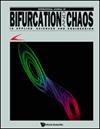Dynamic Analysis, Image Encryption Application and FPGA Implementation of a Discrete Memristor-Coupled Neural Network
IF 1.9
4区 数学
Q2 MATHEMATICS, INTERDISCIPLINARY APPLICATIONS
引用次数: 0
Abstract
This paper presents a novel discrete memristor model that incorporates exponential and absolute value functions. A discrete coupled memristor neural network model is constructed based on this memristor design. The periodic and chaotic regions of the discrete neural network model are determined using bifurcation and Lyapunov exponent spectrum. Furthermore, by varying the initial values of the discrete memristive neural network, we observe the coexistence of chaos and periodic attractors, as well as periodic attractors. Additionally, an application to color image encryption based on the discrete system model is given. Security analysis is conducted in the aspects of key space, histogram analysis, correlation analysis, sensitivity analysis, Peak Signal-to-Noise Ratio (PSNR), and information entropy analysis. The analysis results show that the algorithm has a key space size of [Formula: see text], and the information entropy of baboon graph is 7.9993, which is very close to the ideal value of 8. It shows that the image encryption algorithm is feasible and effective. Finally, the implementation of the discrete memristive neural network model is realized using Field Programmable Gate Array (FPGA). The experimental implementation is conducted using the Verilog language on the Vivado 2018.3 platform, and the obtained results align with the numerical simulation results obtained through MATLAB.离散 Memristor 耦合神经网络的动态分析、图像加密应用和 FPGA 实现
本文提出了一种新颖的离散忆阻器模型,其中包含指数函数和绝对值函数。基于这种忆阻器设计,构建了离散耦合忆阻器神经网络模型。利用分岔和 Lyapunov 指数谱确定了离散神经网络模型的周期和混沌区域。此外,通过改变离散忆阻器神经网络的初始值,我们观察到了混沌和周期吸引子以及周期吸引子的共存。此外,还给出了基于离散系统模型的彩色图像加密应用。从密钥空间、直方图分析、相关性分析、灵敏度分析、峰值信噪比(PSNR)和信息熵分析等方面进行了安全性分析。分析结果表明,该算法的密钥空间大小为[公式:见正文],狒狒图的信息熵为 7.9993,非常接近理想值 8。最后,利用现场可编程门阵列(FPGA)实现了离散记忆神经网络模型。实验实现是在 Vivado 2018.3 平台上使用 Verilog 语言进行的,得到的结果与通过 MATLAB 得到的数值仿真结果一致。
本文章由计算机程序翻译,如有差异,请以英文原文为准。
求助全文
约1分钟内获得全文
求助全文
来源期刊
CiteScore
4.10
自引率
13.60%
发文量
237
审稿时长
2-4 weeks
期刊介绍:
The International Journal of Bifurcation and Chaos is widely regarded as a leading journal in the exciting fields of chaos theory and nonlinear science. Represented by an international editorial board comprising top researchers from a wide variety of disciplines, it is setting high standards in scientific and production quality. The journal has been reputedly acclaimed by the scientific community around the world, and has featured many important papers by leading researchers from various areas of applied sciences and engineering.
The discipline of chaos theory has created a universal paradigm, a scientific parlance, and a mathematical tool for grappling with complex dynamical phenomena. In every field of applied sciences (astronomy, atmospheric sciences, biology, chemistry, economics, geophysics, life and medical sciences, physics, social sciences, ecology, etc.) and engineering (aerospace, chemical, electronic, civil, computer, information, mechanical, software, telecommunication, etc.), the local and global manifestations of chaos and bifurcation have burst forth in an unprecedented universality, linking scientists heretofore unfamiliar with one another''s fields, and offering an opportunity to reshape our grasp of reality.

 求助内容:
求助内容: 应助结果提醒方式:
应助结果提醒方式:


